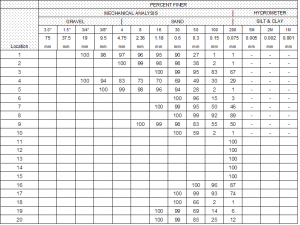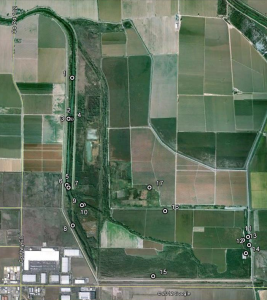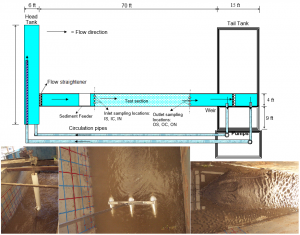Project Description:
Supported by the California Department of Water Resources, laboratory experiments were performed in order to increase understanding of the sediment transport and deposition processes in the Cache Creek Settling Basin (CCSB).
Soil samples were collected in the CCSB for particle size analysis. According to sample analysis, larger size particles deposited as water entered into CCSB in the training channel (locations 1, 2, 3 and 4). Smaller size particles settle either in the Settling Basin under very low flow velocities, or when the water is stagnant. Near the weir (locations 11, 12, 13, and 14) 100% of the particles are silt and clay with diameters less than 0.075 mm.
A sediment tank was built, calibrated and used to release the desired rate of soil into the flume during experiments. Two sets of laboratory tests were planned and performed in order to understand the sediment transport and deposition processes, using the actual sediment brought from the CCSB. The first set of tests were performed to mimic the combined sediment transport and deposition processes. The second set of tests were performed to understand the settling process and the ensemble behavior of settling velocities.
Sediment Transport and Deposition Tests:
Three suspended sediment concentration samples at the inlet and three samples at the outlet (44 feet downstream) were collected simultaneously, at t = 12, 24, 36, 48 and 60 minutes after the valve of the sediment tank was opened. Simultaneous measurements were collected with three DH-48 samplers, connected to each other through a line parallel to the flume bed. The three simultaneous samples at each cross-section account for the variation of the suspended sediment concentration through the inlet/outlet cross-sections. Nine sediment transport and deposition tests were performed under various sweeping velocity, water depth and inlet sediment concentration conditions mimicking natural environmental conditions observed in the CCSB, and later simulated to determine suitability and calibration requirements of a 2-dimensional sediment transport model.
Settling Velocity Tests:
Estimation of the settling velocity of sediment particles in sediment transport is essential to understanding the suspension, erosion and deposition processes in transport phenomena. However, it is still a challenge to accurately estimate the settling velocity. A number of settling velocity relations are available. The laboratory experiments at UCDJAHL measured mean settling velocities using a methodology explained by McLaughlin (1959). Cumulative settling velocity distributions were calculated from the cumulative particle size distributions of suspended particles and the settling velocity equation of Julien (2002). Average sediment concentration samples are collected at times t=0, 6, 10, 20, 30, 60 minutes at three equal depth sections in two water columns simultaneously. 3-foot and 5-foot depths were tested.
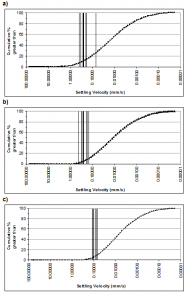
Mean settling velocities at 2-3 ft (from the water surface) section of the 3-feet depth settling velocity tests, superposed on the cumulative settling velocity distribution for a) t=0, b) t=6 min, c) t=30 min
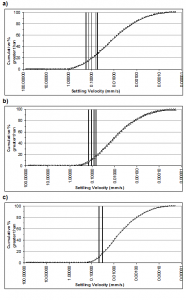
Mean settling velocities at 0-1 ft (from the water surface) section of the 3-feet depth settling velocity tests, superposed on the cumulative settling velocity distribution for a) t=0, b) t=6 min, c) t=30 min
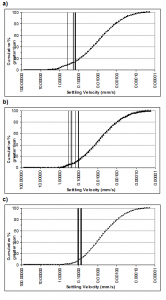
Mean settling velocities at 3.333-5 ft (from the water surface) section of the 5-feet depth settling velocity tests, superposed on the cumulative settling velocity distribution for a) t=0, b) t=6 min, c) t=30 min
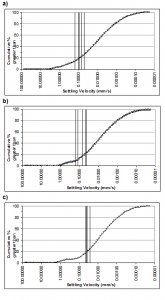
Mean settling velocities at 0-1.667 ft (from the water surface) section of 5-feet depth settling velocity tests, superposed on the cumulative settling velocity distribution for a) t=0, b) t=6 min, c) t=30 min
Julien, P. Y. (2002). River Mechanics. Cambridge University Press.
McLaughlin R.J., Jr. (1959). The settling properties of suspensions. Journal of Hydraulics Division, Proceedings of the American Society of Civil Engineers 85(HY12): 9–41.

